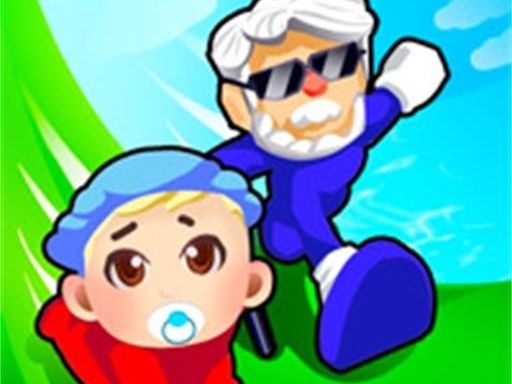Lifetime Running: A Game That Reflects Life’s Journey
In an age where games often prioritize fast action and flashy graphics, Lifetime Running stands apart by offering something deeper—an immersive experience that mirrors real life. This unique parkour game isn’t just about agility or speed; it’s about navigating life’s obstacles with intention and awareness. Whether you’re sprinting through youth or carefully pacing through older age, every moment in the game captures the essence of human existence.
What makes this game captivating is its simplicity. At its core, you select a character and begin a run that symbolizes your life’s journey. Along the way, every decision affects how long and how well you live. It’s more than just a race against time—it’s a lesson in choices, priorities, and consequences.
Let’s explore what makes Lifetime Running a memorable experience and why it resonates so powerfully with players seeking more than just entertainment.
The Beginning: Choosing Your Path
As the game begins, you’re faced with your first important decision: selecting your character. While this may seem purely aesthetic, it subtly symbolizes the different starting points of life. Some begin with more advantages, others with less—but what matters is how you move forward.
Immediately, you’re immersed in a world that’s constantly in motion. The smooth mechanics and colorful yet minimalistic visuals help focus attention on the choices ahead. You’ll encounter gates with time values—each representing a phase of life. Pass through a higher number and you age faster, draining energy. Opt for smaller numbers and you may progress more slowly but conserve your strength. This dynamic makes every run personal and strategic.
It’s a powerful metaphor: in life, rushing may bring rewards faster but at the cost of well-being. The choice is yours, and the consequences are real—just like in everyday life.
Energy, Effort, and the Blood Bar of Life
Perhaps the most compelling feature of Lifetime Running is its blood bar, which represents your vitality. Every action—from jumping over obstacles to crashing into barriers—affects your energy levels. If your blood bar hits zero, the game ends, just as life does when you run out of strength.
This mechanic forces players to think ahead. Reckless choices can quickly drain you, while thoughtful, paced decisions allow for longer survival. It echoes the importance of balance: pushing too hard without replenishment leads to burnout.
But don’t worry—help is available. Scattered throughout the game world are diamonds and food. These items aren’t just points or power-ups—they’re lifelines. They restore energy and provide you with the fuel to continue running. Just like in real life, nourishment—whether physical, emotional, or financial—plays a vital role in keeping us going.
Obstacles and Opportunity: Navigating the Unknown
No life is without challenges, and Lifetime Running makes that clear through its cleverly designed environment. Players encounter numerous obstacles that test timing, reflexes, and judgment. Some are physical—walls to vault, gaps to leap—while others are more subtle, like choosing between two paths with uncertain outcomes.
Each obstacle symbolizes life’s unpredictability. Sometimes you see the hurdle coming and prepare for it. Other times, you’re caught off guard and must react on instinct. In both cases, your response determines the outcome.
What’s beautiful about this part of the game is how it rewards resilience. Even if you fail, you learn. And with each run, you become wiser and more adaptable. That’s not just gameplay—that’s growth.
Diamonds, Food, and the Economy of Life
As you run, you’ll notice shiny diamonds and nourishing food along your path. These items aren’t just collectibles—they’re survival tools. They offer a layer of strategy: do you take the risk to collect them or play it safe and stay on course?
Diamonds represent opportunity—financial, educational, or even emotional rewards. They may require effort or detours, but the payoff is often worth it. Food, on the other hand, reflects the essential needs that sustain you. In the game, as in life, you must constantly balance between reaching for your dreams and ensuring your survival.
What’s fascinating is how these choices stack up over time. Do you chase after diamonds recklessly and deplete your energy, or do you conserve strength and live longer? Again, the game puts the power in your hands, creating an experience that feels deeply personal.
The End Is Just the Beginning: Learning from Each Run
Eventually, every run ends. Your blood bar empties, and the character slows down, symbolizing the inevitable conclusion of life. Yet, instead of feeling defeated, players often feel reflective. What went right? What could they have done differently? How far did they make it, and what did they learn along the way?
This reflection transforms Lifetime Running from a casual game into a meaningful experience. Like journaling at the end of a long day, players look back and analyze their journey. The simplicity of the format makes it accessible, but the emotional depth gives it staying power.
Moreover, each replay offers a new chance. The game resets, but your knowledge stays with you. You improve. You evolve. That’s what makes this game so rewarding—its lessons apply far beyond the screen.
Final Thoughts: A Game with Heart and Purpose
Lifetime Running is more than just a game—it’s a metaphor, a mirror, and in many ways, a guide. It takes the core elements of gameplay and layers them with the realities of life: aging, decision-making, challenges, rewards, and, ultimately, legacy.
With simple controls (a click or tap is all it takes), it invites players of all ages to experience what it means to live thoughtfully. Whether you’re young and curious or older and reflective, the game offers something for everyone.
In a world flooded with games that often forget their players once they’re off the screen, Lifetime Running lingers. It stays in your mind. It sparks conversations. And most importantly, it makes you ask: Am I running my life the way I truly want to?
